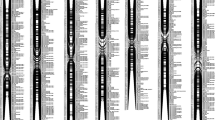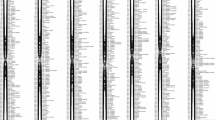Abstract
The development and use of RAPD markers for applications in crop improvement has recently generated considerable interest within the plant breeding community. One potential application of RAPDs is their use for “tagging” simply-inherited (monogenic) pest-resistance genes and enabling more efficient identification and selection of genotypes carrying specific combinations of resistance genes. In this report, we propose and describe the use of heterogeneous inbred populations as sources of near-isogenic lines (NILs) for targeting RAPD markers linked to major pest resistance genes. The development of these NILs for RAPD marker analyses involved a sequence of line and mass selection during successive generations of inbreeding. DNA bulks derived from the NILs were used to identify a RAPD marker (designated OK14620, generated by 5′-CCCGCTACAC-3′ decamer) that was tightly linked (2.23±1.33 centiMorgans) to an important rust [Uromyces appendiculatus (Pers.) Unger var. appendiculatus] resistance gene (Ur-3) in common bean (Phaseolus vulgaris L.). The efficiency of this approach was demonstrated by a low rate of false-positives identified, the tightness of the linkage identified, and the ability to detect polymorphism between genomic regions that are representative of the same gene pool of common bean. This method of deriving NILs should find application by researchers interested in utilizing marker-assisted selection for one or more major pest resistance genes. The identification of OK14620 should help to facilitate continued use of the Ur-3 resistance source and will now enable marker-assisted pyramiding of three different bean rust resistance sources (two previously tagged) to provide effective and stable resistance to this important pathogen.
Similar content being viewed by others
References
Ballantyne BJ (1978) The genetic basis of resistance to rust, caused by Uromyces appendiculatus in bean. PhD Dissertation, Sydney University, Australia
Botstein D, White RL, Skolnick M, Davis RW (1980) Construction of a genetic linkage map in man using restriction fragment length polymorphisms. Am J Hum Genet 32:314–331
Haley SD, Miklas PN, Stavely JR, Byrum J, Kelly JD (1993) Identification of RAPD markers linked to a major rust resistance gene block in common bean. Theor Appl Genet 86:505–512
Haley SD, Miklas PN, Afanador L, Kelly JD (1994) Random amplified polymorphic DNA (RAPD) marker variability between and within gene pools in common bean. J Am Soc Hort Sci 119:122–125
Kelly JD, Adams MW (1987) Phenotypic recurrent selection in ideotype breeding of pinto beans. Euphytica 36:69–80
Kelly JD, Adams MW, Saettler AW, Hosfield GL, Ghaderi A (1984) Registration of C-20 navy bean. Crop Sci 24:822
Kelly JD, Adams MW, Saettler AW, Hosfield GL, Varner GV, Beaver JS, Uebersax MA, Taylor J (1989) Registration of ‘Mayflower’ navy bean. Crop Sci 29:1571–1572
Kelly JD, Adams MW, Saettler AW, Hosfield GL, Varner GV, Uebersax MA, Taylor J (1990) Registration of ‘Sierra’ pinto bean. Crop Sci 30:745–746
Kelly JD, Hosfield GL, Varner GV, Uebersax MA, Miklas PN, Taylor J (1992) Registration of ‘Alpine’ Great Northern bean. Crop Sci 32:1509–1510
Martin GB, Williams JGK, Tanksley SD (1991) Rapid identification of markers linked to a Pseudomonas resistance gene in tomato by using random primers and near-isogenic lines. Proc Natl Acad Sci USA 88:2336–2340
Melchinger AE (1990) Use of molecular markers in breeding for oligogenic disease resistance. Plant Breed 104:1–19
Michelmore RW, Paran I, Kesseli RV (1991) Identification of markers linked to disease resistance genes by bulked segregant analysis: a rapid method to detect markers in specific genomic regions using segregating populations. Proc Natl Acad Sci USA 88:9828–9832
Miklas PN, Stavely JR, Kelly JD (1993) Identification and potential use of a molecular marker for rust resistance in common bean. Theor Appl Genet 85:745–749
Moh CC (1971) Mutation breeding in seed-coat colors of beans (Phaseolus vulgaris L.) Euphytica 20:119–125
Nodari RO, Tsai SM, Gilbertson RL, Gepts P (1993) Towards an integrated linkage map of common bean. 2. Development of an RFLP-based linkage map. Theor Appl Genet 85:513–520
Paterson AH, Tanksley SD, Sorrells ME (1991) DNA markers in plant improvement. Adv Agron 46:39–90
Singh SP, Gepts P, Debouck DG (1991) Races of common bean (Phaseolus vulgaris, Fabaceae). Econ Bot 45:379–396
Stavely JR (1984a) Genetics of resistance to Uromyces phaseoli in a Phaseolus vulgaris line resistant to most races of the pathogen. Phytopathology 74:339–344
Stavely JR (1984b) Pathogenic specialization in Uromyces phaseoli in the United States and rust resistance in beans. Plant Dis 68:95–99
Stavely JR (1988) Rust resistance in beans: the plant introduction collection as a resource and resistant development. Annu Rep Bean Improv Coop 31:64–65
Stavely JR, Grafton KF (1989) Registration of BELDAK-Rust Resistant-1 and -2 pinto dry bean germplasm. Crop Sci 29:834–835
Stavely JR, Steadman JR, McMillan RT (1989) New pathogenic variability in Uromyces appendiculatus in North America. Plant Dis 73:428–432
Stavely JR, Steinke J, McMillan RT, Jr, Grafton KF, Steadman JR, Kelly JD, Coyne DP, Lindgren DT, Silbernagel MJ (1992) Rust-resistant bean germplasm releases. Annu Rep Bean Improv Coop 32:228–229
Tanksley SD, Orton TJ (1983) Isozymes in plant genetics and breeding, parts 1A and 1B. Elsevier Science, Amsterdam, Netherlands
Vallejos CE, Sakiyama NS, Chase CD (1992) A molecular marker-based linkage map of Phaseolus vulgaris L. Genetics 131:733–740
Welsh J, McClelland M (1990) Fingerprinting genomes using PCR with arbitrary primers. Nucleic Acids Res 24:7213–7218
Williams JGK, Kubelik AR, Livak KJ, Rafalski JA, Tingey SV (1990) DNA polymorphisms amplified by arbitrary primers are useful as genetic markers. Nucleic Acids Res 18:6531–6535
Wood DR, Keenan JG (1982) Registration of Olathe bean. Crop Sci 22:1259–1260
Young ND, Zamir D, Ganal MW, Tanksley SD (1988) Use of isogenic lines and simultaneous probing to identify DNA markers tightly linked to the Tm-2a gene in tomato. Genetics 20:579–585
Author information
Authors and Affiliations
Additional information
Communicated by A. L. Kahler
Research supported in part by the grant DAN 1310-G-SS-6008-00 from the USAID Bean/Cowpea Collaborative Research Support Program, the Michigan Agricultural Experiment Station, and the USDA-ARS. Mention of a trademark or a proprietary product does not constitute a guarantee or warranty of the product by the USDA and does not imply its approval to the exclusion of other products that may also be suitable
Rights and permissions
About this article
Cite this article
Haley, S.D., Afanador, L.K., Miklas, P.N. et al. Heterogeneous inbred populations are useful as sources of near-isogenic lines for RAPD marker localization. Theoret. Appl. Genetics 88, 337–342 (1994). https://doi.org/10.1007/BF00223642
Received:
Accepted:
Issue Date:
DOI: https://doi.org/10.1007/BF00223642




